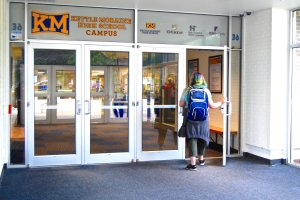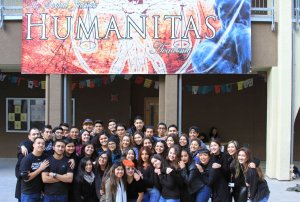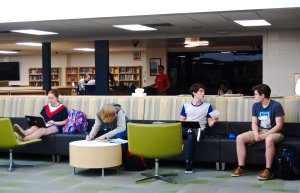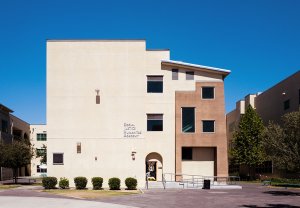We Need More SEL in High Schools (Here’s How)
Through advisory groups, orientations, and one-to-one coaching, schools are helping incoming students adjust to the social and emotional challenges of high school.
Your content has been saved!
Go to My Saved Content.When I first started student teaching at a high school where students were diligent and unfailingly polite, I asked my co-teacher where the tough students were. “Still in ninth grade,” she said. A decade later, I understand her real meaning: It’s not the kids who are tough, it’s the high school system.
Freshman year throws still-developing adolescents together and asks them to navigate shifting friends, classes, and clubs—and the allure of drugs, sex, and popularity—all while their bodies and brains are undergoing enormous changes. Many come from different, smaller middle schools and start high school with a range of backgrounds that impact how well or poorly they adapt. Though some high schools offer support for kids who show up confused or unsure—like tutoring and counseling sessions—many do not, which can leave students struggling to find their footing. Some never do.
According to several studies, more students fail ninth grade, and there are more disciplinary issues, than any other grade of high school. Ninth grade is also a critical make-or-break year for students that can determine whether they will graduate from high school and enroll in college. More recently, the system has been flashing red: Studies reveal major upticks in adolescent mental health issues and newly unsustainable levels of stress. A nationally representative survey found adolescents (aged 12 to 17) reporting a major depressive episode in the last year increased 52 percent from 2005 to 2017.

“When students make the transition to high school, they are in an incredibly vulnerable time of their life—their adolescent development, brain development, social circles, and peer relationships are changing all at once,” says Alex Seeskin, chief strategy officer at the Urban Education Institute at the University of Chicago, a research group that trains teachers and school leaders. “In the midst of all this change, students adapt a new set of academic and social identities that stick with them throughout the rest of their high school education.”
Yet high schools, for a variety of reasons, aren’t typically set up to address students’ social and emotional needs. As soon as they enter ninth grade, high school students are expected to take a rigorous course load, where their performance can impact college choices; teachers become subject-matter experts who typically instruct students in one class only; and guidance counselors are in short supply.
Recognizing the gravity of this transition, and the opportunity, some schools are giving students more support as they make the leap into high school. Through advisory groups, orientation days, peer mentoring programs, and other resources, educators are helping students, virtually and in person this year, develop both the social and emotional wellness and the academic confidence they need to succeed for the next four years.
Simple Strategies Make Students Feel Welcome
Principal Sean Stevens tells his new high school students at KIPP Newark Collegiate Academy in New Jersey, that they are “eighth graders plus two months”—and will need help navigating an entirely new system. That might not feel like much, says Stevens, but one of the most important things a school can do to help students adapt is the simplest: acknowledge the difficulty of the transition and make them feel welcome.
For adolescents, in particular, a sense of belonging created within the first few weeks can translate into academic success and motivation to succeed, while a sense of disconnectedness can marginalize kids and increase their risk of disengaging—or dropping out. Research and brain science strongly indicate that students who feel their teachers and peers value them and their contributions are also more likely to be motivated, be confident, pass more courses, and graduate on time.
“[In ninth grade], students are learning how to do high school but also figuring out, ‘Do I belong? Can I succeed?’” says Elaine Allensworth, director of the University of Chicago Consortium on School Research.
Through freshman orientations and advisory groups, schools can give students a support system on campus that can help them troubleshoot challenges—and make them feel connected.
At the start of every school year at Social Justice Humanitas Academy, a high school in San Fernando, California, where 90 percent of the students are low income, freshmen come to school two weeks early and work on hands-on, collaborative projects like drawing chalk art murals and engineering toy roller-coasters to help break the ice with their peers. The focus continues throughout the year when students are able to participate in student “councils” where they can bring up school and personal challenges and problem-solve them together.

Students who attend the school come from nearly a dozen middle schools and can easily feel lost without any support, say staff. “We want kids to start the year with a growth mindset and feeling seen,” says Vice Principal Marike Aguilar.
Similarly at Kettle Moraine High School in Wales, Wisconsin, the first day of school is for freshmen only. Teachers clap when students enter the building for the first time to set an uplifting tone, says Alyssa Voight, the coordinator for secondary schools. After playing games together and taking a tour of the school, students split into small advisory groups that they’ll stick with for the rest of high school.
These groups of about 15 students meet once a week throughout their four years, discussing key grade-level information and developing relationships with peers and an adult at the school. All staff—even the principal—are required to run one. This year, during the pandemic, advisories will still continue and meet virtually if needed.
According to Voight, the small groups help ensure that students who may be struggling don’t slip by. “Advisory allows one person to see a larger pattern in the student’s life,” says Voight. There is “not one specific teacher otherwise who looks at how that student is doing in all of their courses.”
Making Room for Mistakes
Adolescents (especially freshman) can easily get overwhelmed in large schools, shifting classes from period to period and interacting with new teachers they see only briefly. Many have not mastered the study and work habits required to handle the rigorous workload and lack the coping skills to manage higher levels of stress. In a Pew Research Center study of 13-to-17-year-olds, 70 percent of participants said anxiety and depression were a major problem in their age group; many cited academics as one of their main stressors.
A pervasive and really destructive myth is that tough grading teaches ninth graders how to work through high school, but many high school students—lacking a mature prefrontal cortex and prone to more impulsive behavior—don’t have the capabilities or the coaching to process feedback and improve. Instead, they need room to learn from their mistakes, and techniques to course-correct in the future, before they are saddled with failing grades, according to Sarah Duncan at the Network for College Success, a research group at the University of Chicago that works with local high schools.
“Most kids will interpret an F not as a challenge to work harder but as a message that ‘you don’t belong and you are not good enough,’” says Duncan, who recommends that teachers grade according to standards or mastery (rather than the traditional 0–100 curve) and offer reassessments if a student struggles or submits subpar work but wants to try again.

Similarly, at George Washington High School, where 86 percent of students are low income, Principal Kevin Gallick says staff are providing one-on-one coaching with students to help them recognize where they stand in a class and take steps to improve.
“Years ago, you would have kids in the third year of high school not on track to graduate, but they didn’t even know it,” says Gallick. “We support freshmen as early as possible to take ownership for their own performance, to access their grades, and understand the importance of grades.”
During a common time at lunch, students can see teachers for reassessments. Staff also make an effort to recognize students for skills not measured by traditional grading systems, like leadership, by providing mentorship opportunities—for example, a one-on-one breakfast with the principal. These commendations for non-academics can, in turn, motivate kids to try harder in class, Gallick said.

Meanwhile, at Humanitas Academy, students have scheduled time to have individual conversations with teachers to talk through their academic challenges while building a relationship with an adult. They even participate in monthly steering committees with other students and administrators, during which they can help change academic protocols that can be barriers to their success, such as making sure that not all tests are on the same day.
When a ninth grader has time—and support—to acknowledge and address problems, that becomes a skill that carries through high school and beyond, says Humanitas principal Jeff Austin. “Historically, [it’s] been one of those challenges to get to a kid to realize at the end of the ninth grade: I accomplished something; I have to account for my mistakes, but I have the space to do that. If you can get them through that, [you have done] the toughest part.”
